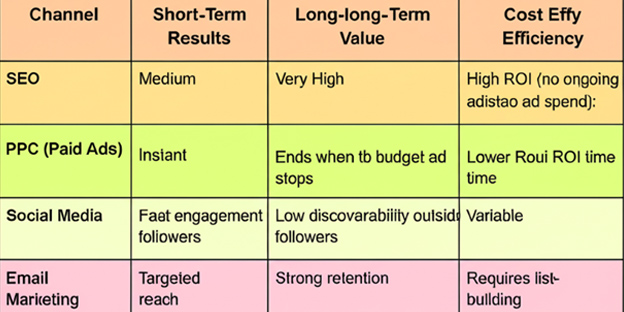

SEO stands for search engine optimization and is an important part of any digital marketing strategy. Actually knowing how SEO works in digital marketing enables business establishments to improve their rankings on the search engines so as to attain their set marketing objectives.
Understanding how SEO works in digital marketing is crucial as information technology advances. Search engines such as Google, Yahoo, and Bing have been the first point of contact for users on the Internet. After a user enters a query, the search engine’s algorithms scan through millions of websites so the user gets the most relevant and authoritative sites.
SEO is the act of using specialized techniques to integrate your website and individual content into the SERPs of these search engines. An SEO agency in Bangalore can help your website appear in the SERPs; the greater its visibility, the targeted visitors it stands to gain and hence higher conversions and sales.
Search Engine Optimization (SEO) in digital marketing is the process of optimizing your website and online presence so that search engines like Google, Bing, and Yahoo display your pages higher in the Search Engine Results Pages (SERPs).
At its core, SEO ensures that your business is discoverable by the right audience at the right time—when they are actively searching for products, services, or solutions you offer. Unlike paid advertising (PPC), which stops driving traffic once your budget runs out, SEO creates a sustainable flow of organic traffic over the long term.
Google’s latest updates—including the Helpful Content Update, E-E-A-T guidelines, and Search Generative Experience (SGE)—have changed the SEO landscape:

This shows that SEO is the backbone of digital marketing, supporting and amplifying the impact of all other channels.
SEO works by aligning your website with how search engines discover, evaluate, and rank content. Understanding this process is critical if you want to rank in competitive industries.
Step 1: Crawling
Search engines use bots (spiders) to scan the web for new and updated pages.
2025 Best Practices for Crawling
Once crawled, pages are stored in Google’s massive database, known as the search index.
When a user searches, Google’s algorithm decides which pages deserve to appear first. This ranking is based on hundreds of signals, but the most important in 2025 are:
SEO works by making your site easily discoverable (crawling), valuable (indexing), and authoritative (ranking). In 2025, the winners are not just those who insert keywords, but those who deliver genuinely useful, expert-backed, structured content.
To truly understand how SEO works in digital marketing, it is important to know it’s a complex and intricate practice area, encompassing a number of work methods and approaches. These can be broadly categorized into two main areas: on-page SEO and off-page SEO.
On-page SEO is the process of optimizing different elements of a website to make the site more receptive to search engines. Understanding how SEO works in digital marketing helps optimize these elements:
Finding out and using frequently searched and yielding keywords and phrases, which are relevant to your target consumers, in your website text and tags.
Developing relevant, useful, enjoyable, and expert content that answers the question or solves the problem of your target. This comprises not only choosing appropriate keywords, the content organization, and focusing on the content readability and relevance.
Making your website mobile-friendly, fast, and comprehensible, as well as meeting all the requisites of the proper URL structure, website structure, and other factors that affect the SEO results.

Converting and Writing Effective Meta Titles and Descriptions that would help to reflect on the main content of web pages and get clicked.
Off-page SEO involves building your website's authority and credibility in the eyes of search engines through external factors, such as:
Having a site with relevant quality backlinks from other reputable and related sites will inform the search engines that your information is worthy of being shared.
Spamming your channels and refreshing them with posts, as these signals can help boost your website’s rank in the search engines.
Overseeing company identification of negative comments and isolated unfavorable reputations as well as active promotion of a favorable company reputation.
For SEO to deliver results, every component must align with Google’s ranking signals and user intent. In 2025, the following elements are critical:
Tip: Add expert author bios, cite credible sources, and use first-hand insights to strengthen content trust.
Tip: Use tools like Google Search Console, SEMrush, or Ahrefs to find People Also Ask (PAA) queries and optimize FAQ sections.
Tip: Compress images, use a CDN, and minimize heavy scripts to improve site speed.
Tip: Target industry-relevant sites, create link-worthy content (guides, statistics), and avoid buying cheap links.
Tip: Use clear titles, engaging intros, multimedia (videos, infographics), and internal links to improve engagement.
Bottom Line: SEO success depends on a balance of content quality, technical health, and authority signals. Google now rewards sites that serve users first and provide seamless digital experiences.
Implementing SEO effectively requires a step-by-step roadmap that blends technical optimization, content creation, and authority-building.
Pro Tip: SEO should not be treated as an isolated task—it must be integrated with your content marketing, paid ads, and social media to maximize results.
SEO is evolving rapidly, influenced by AI, voice search, and personalization. Businesses must adapt to stay ahead.
Future Outlook: SEO is no longer just about ranking pages—it’s about owning visibility across multiple digital touchpoints (SERPs, AI summaries, voice, and visual search).
Digital marketing needs a strategic and continuous approach when it comes to SEO because it covers both on-page and off-page SEO. Here are some key steps to implement SEO strategies:
First, find out which keywords will be more relevant and bring higher conversions to your type of business. Some of the factors to consider will include the number of searches conducted, the competition level, and the level of relevance to your target audience.
Make sure that the text on your site will be interesting and full of valuable information as well as containing the keywords that are relevant to the audience. This involves the use of a good site map, the proper use of header tags, and the use of proper keywords with proper density on the site.
Your website loading speed should be low, its design should be responsive, and it should adhere to all of the rules concerning website architecture, URL architecture, and other crucial factors that might influence your SERP ranking.
Build a link-building plan to get relevant and high-quality links from reputable sites within your business niche. This can include writing for other sites, digital PR, and more that you can undertake as a blogger.
You must frequently monitor your website and the SEO statistics so as to analyze for possible weaknesses and check on the status of your search engine rankings.

Since search engines and their users change, understanding how SEO works in digital marketing must also evolve to remain relevant. As a leading digital marketing company in Bangalore, we suggest some of the emerging trends in SEO including:
Due to the rising use of smart devices by people such as Echo, Cortana, and Amazon, it is high time you implemented SEO for voice search queries. These might include adopting looser language than a standard query, longer words commonly known as long tails, and using marked-up data.
Mobile-friendly was already an important factor in Google’s ranking factors; thanks to mobile-first indexing, your mobile experience is now vital. Another is to make sure your website looks good, works fast, and is optimized for use with mobile devices.
Today, search engines are able to capture user intent and context much better than before because of changes in the use of artificial intelligence and machine learning. This means marketers need to deliver content that fits well with these changing algorithms, best-practicing relevance, authority, and user experience.
As a result of such an emphasis on user experience, such aspects as page speed, interactivity, and visual stability became crucial and are now measured by Google through Core Web Vitals.
Through being aware and adaptive, companies can use SEO as a strong driver of the promotion process and a key to increasing website visitors and, subsequently, the number of buyers.

As the complex technologies and platforms in the Internet space are actively developing, it is especially important for companies that seek to rate their projects to know how SEO works in digital marketing. On-page and off-page SEO strategies must form an integrated plan to help companies enhance their rank, acquire better web traffic, and meet marketing objectives. Since search engine operation and consumers’ habits are in a constant state of change, ensuring that you are aware of the current trends and strategies for SEO will be crucial for allowing you to achieve a successful presence on the Internet.